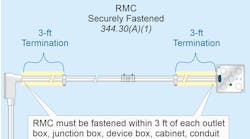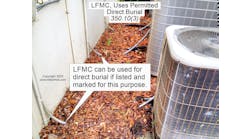Stumped By the Code? Identification Required by the NEC for Neutral Conductors
All questions and answers are based on the 2020 NEC.
Underlined text indicates revisions made in the 2020 Edition of the NEC
Q. What identification is required by the NEC for neutral conductors?
A. Section 200.6 Identification of Grounded Conductors
(A) 6 AWG or Smaller. Neutral conductors 6 AWG and smaller must be identified by any of the following means:
(1) Insulated conductors with a continuous white outer finish
(2) Insulated conductors with a continuous gray outer finish
(3) Insulated conductors with three continuous white or gray stripes along its entire length on other than green insulation
(4) Insulated conductors with their outer covering finished to show a white or gray color but have colored tracer threads in the braid identifying the source of manufacture. Comment: The use of white tape, paint, or other methods of identification is not permitted for neutral conductors 6 AWG and smaller.
(B) 4 AWG or Larger. Neutral conductors 4 AWG or larger must be identified by any of the following means:
(1) A continuous white outer finish along their entire length
(2) A continuous gray outer finish along their entire length
(3) Three continuous white or gray stripes along their length
(4) White or gray tape or markings at the terminations.
(E) Neutral Conductors of Multiconductor Cables. Insulated neutral conductor(s) sized 6 AWG and smaller in multiconductor cables must be identified by a continuous white or gray outer finish, or by three continuous white or gray stripes. Conductors in multiconductor cables sized 4 AWG or larger can have the neutral conductor identified in accordance with Sec. 200.6(B).
Exception No. 1: Conductors within multiconductor cables are permitted to be re-identified at their terminations at the time of installation by a distinctive white or gray marking.
Q. What are the NEC requirements for the bonding and grounding of fountains?
A. Section 680.54 Grounding and Bonding
(A) Connection to Equipment Grounding Conductor (EGC). The following equipment must be connected to the circuit EGC:
(1) Other than listed low-voltage luminaires not requiring grounding, all electrical equipment located within the fountain or within 5 ft of the inside wall of the fountain.
(2) All electrical equipment associated with the recirculating system of the fountain.
(3) Panelboards that are not part of the service equipment and that supply any electrical equipment associated with the fountain.
Note: See Sec. 250.122 for sizing of these conductors.
(B) Bonding. The following parts must be bonded together and connected to an EGC of the branch circuit supplying the fountain:
(1) All metal piping systems associated with the fountain
(2) All metal fittings within or attached to the fountain
(3) Metal parts of electrical equipment associated with the fountain water-circulating system, including pump motors
(4) Metal raceways within 5 ft of the inside wall or perimeter of the fountain and not separated from the fountain by a permanent barrier
(5) All metal surfaces within 5 ft of the inside wall or perimeter of the fountain and not separated from the fountain by a permanent barrier
(6) Electrical devices and controls that are not associated with the fountain and are located less than 5 ft of the inside wall or perimeter of the fountain.
Q. What is the Code requirement for the GFCI protection of pool pump motors?
A. Section 680.21 Pool Motors
(A) Wiring Methods. The wiring to a pool-associated motor must comply with Sec. 680.21(A)(1) unless modified by (A)(2) or (A)(3).
(1) General. Branch-circuit wiring for pool-associated motors installed in corrosive locations must be rigid metal conduit (RMC), intermediate metal conduit (IMC), rigid polyvinyl chloride conduit, reinforced thermosetting resin conduit [Sec. 680.14], or Type MC cable listed for the location.
The wiring methods must contain an insulated copper equipment grounding conductor (EGC) sized in accordance with Sec. 250.122, but in no case can the EGC be sized smaller than 12 AWG.
Where installed in noncorrosive environments, any Chapter 3 wiring method is permitted.
(2) Flexible Connections. Liquidtight flexible metal or liquidtight flexible nonmetallic conduit are permitted.
(C) GFCI Protection. GFCI protection is required for all pool motors rated 60A or less, at not over 150V to ground, single- or 3-phase, whether by receptacle or by direct connection.
Exception: Listed low-voltage motors not requiring grounding, with ratings not exceeding the low-voltage contact limit supplied by transformers or power supplies that comply with Sec. 680.23(A)(2), may be installed without GFCI protection.




